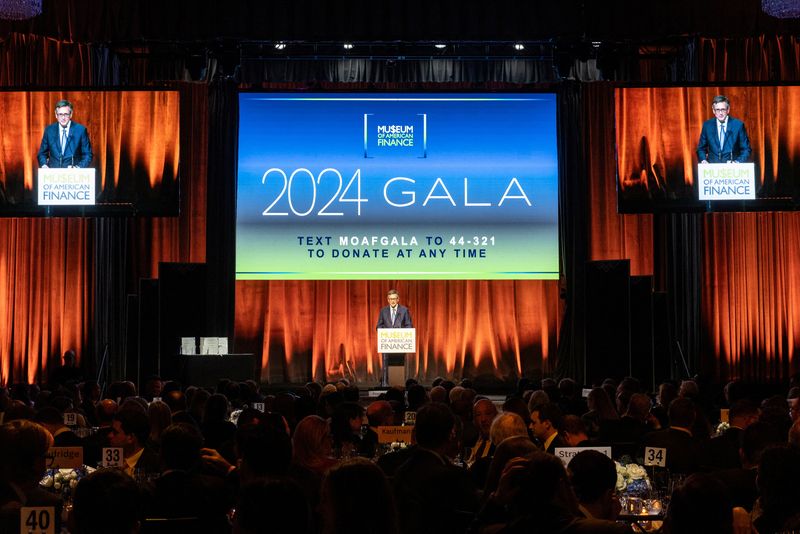
©Reuters. Former Federal Reserve Vice Chairman Richard Clarida speaks during the Museum of American Finance gala at the Ziegfeld Ballroom in New York City, U.S., March 7, 2024. REUTERS/Jeenah Moon
2/5
By Lananh Nguyen
NEW YORK (Reuters) – Financial industry heavyweights gathered in New York last week to raise money for a finance museum that has lost its iconic Wall Street address.
At the Museum of American Finance (NASDAQ:) gala, billionaire Ken Griffin welcomed attendees on huge video screens in Manhattan’s art deco Ziegfeld Ballroom. Mark Carney, president of Brookfield Asset Management (TSX:) and former governor of the Bank of England, honored former Federal Reserve vice chair Richard Clarida. JPMorgan Chase (NYSE:) and Wells Fargo bought tables.
“The philosopher Santayana said: those who ignore history are condemned to repeat it,” Howard Marks, billionaire co-founder of Oaktree Capital Management, told Reuters before receiving an award. “This is equally true in the investment industry: those who ignore history are doomed to lose money and/or miss opportunities.”
The 455 participants raised $1.5 million for the museum. Yet his collection – which includes a bond signed by George Washington, a ticker tape from the 1929 stock market crash and the first examples of US currency – languishes in temporary storage in Georgia after spending several years in New York’s Queens borough City.
At the gala, guests dined on burrata and braised beef short ribs. They murmured in appreciation when a bond for the Louisiana Purchase – which doubled the size of the United States – was projected on big screens. A reference to President Ronald Reagan received some applause.
Carney shared a lesson from his time at Goldman Sachs.
“If someone in our industry explains something to you … and that explanation doesn’t make sense to you, ask them to repeat it — and if it still doesn’t make sense, walk away,” he said. “When fake knowledge masks real ignorance, it leads to panic.”
Clarida, a professor at Columbia University and consultant to asset manager PIMCO, expressed pride in the Fed’s response to the pandemic while accepting an award.
“The Fed acted decisively and expansively in the spring of that year to prevent what could well have escalated into an economic depression and financial crisis,” he said. “The Fed’s nimble and creative response to the pandemic collapse represents the Fed at its best.”
Like many other businesses, the finance museum has suffered during the Covid-19 pandemic after facing other setbacks.
Its former headquarters at 48 Wall Street was itself a part of financial history, serving as the original headquarters of the Bank of New York founded by Alexander Hamilton. The museum opened in 2008 on the eve of the global financial crisis.
Since then his objects and documents have made a long journey. In 2018, they were displaced when a pipe burst damaged the museum’s three floors, including the large exhibition hall. Last summer, the collection was loaded onto a tractor trailer and transported from Queens to the Georgia archive.
“We have not lost sight of the value of a physical home for our museum,” Financial Museum President and CEO David Cowen told attendees. “We are discussing discounted or donated spaces, but it is not too late – if you would like to host this incredible museum, come talk to us.”
The museum still publishes a magazine, holds virtual conferences and organizes events hosted in other spaces. It has an eight-box traveling exhibit that can be rented to generate revenue.
While waiting for a permanent space, the museum has digitized 500 boxes containing 300,000 pages, while 835 of its objects have also been processed by archivists.
Lina Lin, a freshman at Yale University who received a scholarship from the museum, has never seen the exhibits in person. Her interest in economics was piqued when she took the museum’s virtual personal finance course as a high school student.
“The most surprising thing was the amount of people who don’t have access to financial education,” Lin said. “I would prefer a physical location just because it’s more centralized…it’s more like a gathering place.”